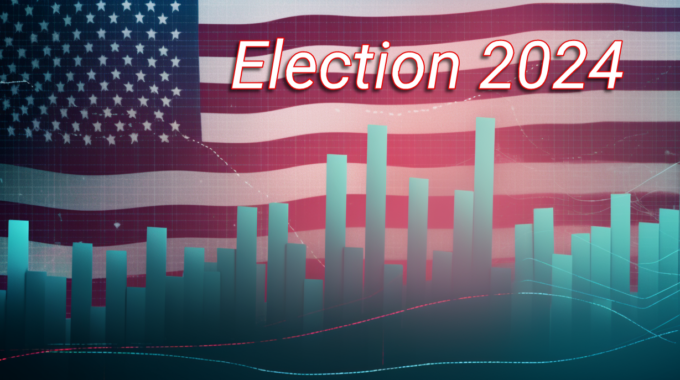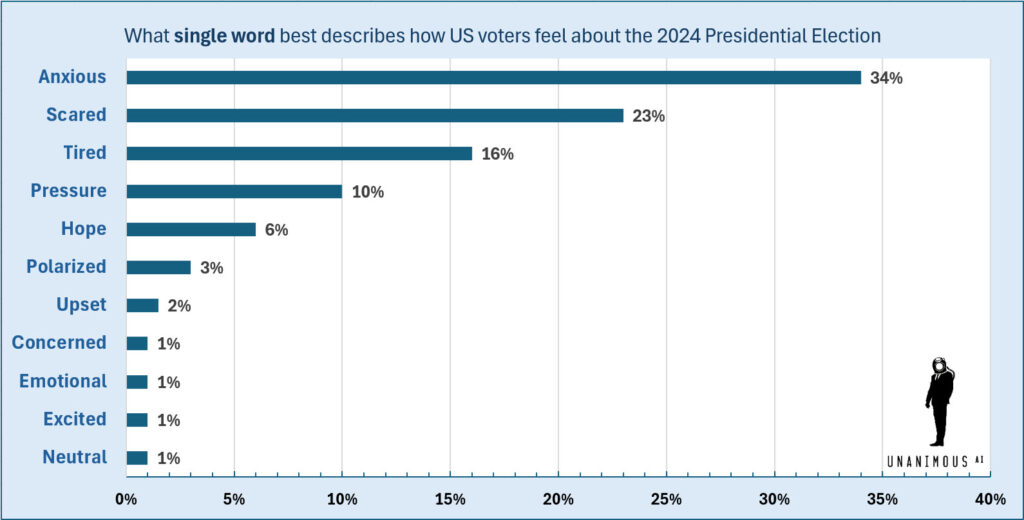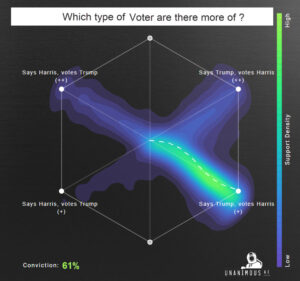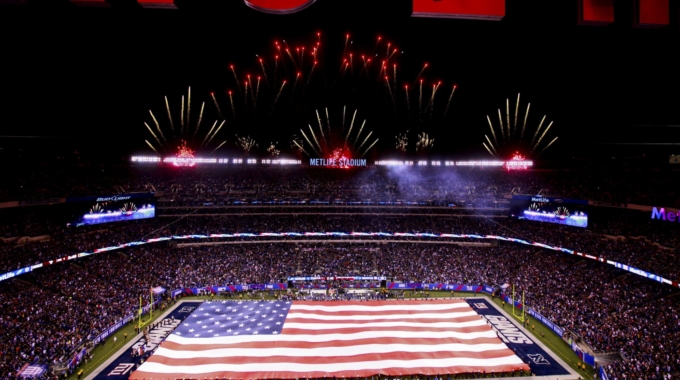
At Unanimous AI, we don’t replace people with algorithms. Instead, we connect large human groups together to form super-intelligent systems. Over the last decade, we have predicted many high-profile events, often at the request of journalists who want to test our forecasting abilities. This started back in 2016 when a CBS reporter challenged us to predict the Kentucky Derby, not just the winner but the first four horses in order. We did it, beating 540-1 odds and worldwide headlines: Newsweek Article 2016.
We also predict elections, but we keep our forecasts narrow in scope and meaning. Back in 2020, we used our Swarm AI technology to predict who would win in each of the 11 battleground states. We gave those forecasts to the Wall Street Journal and as they reported on Nov 6, 2020, we correctly predicted 10 of the 11 battleground states. That was far better than any of the national polls.
Of course our technology has advanced since 2020. Our latest platform is called Thinkscape™ and it enables large groups (up to 400 people) to hold real-time deliberative conversations and converge on optimized solutions. And because it’s conversational, Thinkscape outputs detailed qualitative reasons why the system supports the most likely outcome.
This makes Thinkscape a remarkable tool for harnessing the intelligence of large groups, enabling teams up to 400 people to brainstorm and deliberate in real-time and converge on deep insights. It’s also a powerful tool for market researchers who want to quickly capture qualitative insights at statistical scale. For info on how Thinkscape works: 2 minute explainer video.
Enough background…. What about the 2024 ELECTION?
We gathered 112 randomly selected voters (of mixed party, gender, state, etc.) in our Thinkscape platform and had them deliberate as a real-time Collective Superintelligence that can generate far deeper insights than traditional polls, surveys, interviews, or focus groups. The first thing we asked them was, “How is everyone feeling about the election?”
We did this by having the participants brainstorm together in Thinkscape to come up with the BEST SINGLE WORD that describes how American voters feel about the election right now. Remarkably, this extremely diverse group was in strong agreement about the top words that describe how America feels about this election and it’s NOT positive. Here are the results:

Although most Americans clearly have strong negative feelings about this election, it was heartening to observe this diverse group of voters, with very different views and backgrounds, have a civil conversation inside Thinkscape and realize collectively that they have similar fears and concerns. (Note, everyone was anonymous – nobody knew the name, gender, ethnicity, party affiliation, or resident state, etc., of anyone else).
Next we wanted to collect data that could shed light on the polls in battleground states. This is difficult because there are many issues that can skew polls from incorrect assumptions about voter turnout to sampling bias resulting from different groups responding to polls in higher numbers. The issue that we were most interested in investigating was voters who are untruthful to pollsters, telling them they will vote for A but really intending to vote for B.
This happens in every election and is often referred to as the “shy voter” problem because these individuals are not out to deceive pollsters, they simply don’t feel comfortable telling a pollster who they really intend to vote for. In fact, these people may not feel comfortable telling their friends, neighbors, family, or even spouse who they really intend to vote for. Accordingly to Pew Research, approximately 11% of voters in the 2016 election fell into this category. We can assume something similar this time around.
So, a significant question in the 2024 election is this: Are there more “shy voters” in one direction versus the other. Obviously, if there are a similar number of shy Harris voters vs shy Trump voters in the battleground states, this phenomenon won’t impact the polls. But if there is a skew in one direction, it could mean the polls are off.
To study this, we took a two step process. First, we had the 112 randomly-selected voters discuss (together in Thinkscape) the following question: “Think about the people you know in your community (friends, neighbors, relatives, coworkers). Some may be lying about who they plan to vote for. What type of voter is most likely to be lying and why?” The results were fascinating and surprising.
On both sides, voters expressed that some people they know may feel significant social pressure to hide who they really intend to vote for. On both sides, voters expressed “fear of backlash” and “fear of being judged” as primary reasons, and some even expressed “fear of violence” or “fear of vandalism.” In all cases, the people likely to be untruthful were described as those who intend to vote for someone different than the prevailing sentiment in their community. Although these are not positive feelings, it was again heartening to observe that this diverse group of voters, with different views and backgrounds, had a civil conversation in Thinkscape and realized collectively they have similar fears and feel similar pressures.
Next we asked the same mixed group of voters to predict which group is larger, shy Harris voters who are telling people they support Trump, or shy Trump voters who are telling people they support Harris. Surprisingly, there was a strong sentiment among both Harris supporters and Trump supporters that there are likely more shy Harris voters than shy Trump voters, especially in conservative communities within swing states The data generated looked like this:

What does this mean for the polls?
Out of every 100 voters, we can estimate about 10% are not truthful to pollsters (in 2016, Pew reported 11%). If for every 10 untruthful voters in battleground states, there are 6 shy Harris voters and 4 shy Trump voters, that would mean the polls are undercounting Harris voters by 1% and overcounting Trump voters by 1%.
As for the reasons behind the skew, many things drive people to hide their true voting intentions from friends, family, coworkers, and pollsters. These pressures exist on both sides, but the imbalance this year may be because of women voters in conservative families or communities who will vote for Harris but don’t feel comfortable expressing that intention publicly.
Of course, there are other errors that impact polls, like turnout estimations errors and sampling bias, but we did not study those issues. Still, our analysis suggests the published polls likely have a shy voter error within them that are undercounting Harris.
The Big Picture:
At Unanimous AI, we believe polls are polarizing, driving people to divide and entrench, which hides their true feeling and reinforces national divisions. On the other hand, when you bring large groups together to deliberate conversationally at scale, they converge on the insights that they truly best agree upon. This is why we built Thinkscape.
For more info on Thinkscape and its remarkable power to harness and amplify group intelligence, visit: https://www.thinkscape.ai/



